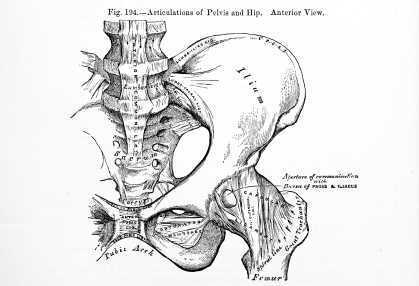Avulsion Fractures and Pelvic Pain

Avulsion fractures refer to a forcible separation, or tearing away of bone due to a sudden and powerful contraction of muscle. This injury is most common in adolescents, with the as yet developing growth plates being a likely location of avulsion. A systematic review of the literature published in 2011 describes the pathology of pelvic avulsion fractures as "highly prevalent" among adolescent athletes. Additionally, patients who have mature skeletons and who have a history of prior surgical interventions to the bones are also at risk for pelvic avulsion fractures.
Avulsion fractures appear to occur most commonly during the eccentric phase of muscle activity during sporting activities. Pre-existing pain in hip or pelvis may be present, but is not a reliable predictive sign of subsequent fracture. Included in this review article were 48 case reports and case series of which 88% related to physical activity and the remaining 12% related to previous surgical procedures. Within the cases related to physical activity, the mean age of fracture in subjects was 16.8, with 84% being male. Activities in which subjects were involved involved included soccer, gymnastics, and running sports. In the cases related to surgery, mean age of fracture was 56.4, and 100% were female. All of the surgery-related cases presented in the literature were treated with conservative measures. Conservative care described included a period of bed rest for 3 days progressing to walking with crutches until the patient was able to walk without significant pain.
Symptoms reported by patients who have suffered an avulsion fracture of the pelvis may include reporting a popping sensation, local pain, and difficulty walking. Having had a bone harvest from the iliac crest may also predispose a patient to a subsequent avulsion fracture. The authors state that surgery may be considered when there is greater than 2 centimeters of displacement of the avulsion or if the ischial tuberosity is involved.
Rehabilitation therapists should be alert to the age, activity levels, and histories of patients who present with pelvic and hip pain, as an avulsion fracture may be the source of pain. Radiographic imaging will provide further information upon which a plan of care can be made. If you would like to learn more about diagnosing pelvic pain, join your colleagues at one of our courses aimed towards identifying sources of pelvic pain. Peter Philip's continuing education course titled Differential Diagnostics of Chronic Pelvic Pain will next be offered in July of next year in Arlington, VA. Another popular course called Finding the Driver in Pelvic Pain was created by faculty member Elizabeth Hampton and will be offered in April in Milwaukee, WI.
By accepting you will be accessing a service provided by a third-party external to https://hermanwallace.com./








































